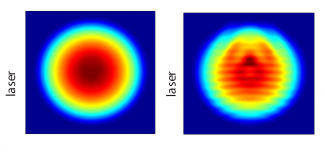The Bohn group has just come up with an exciting, really complicated experiment for someone else to do. This is something theorists like graduate student Ryan Wilson, former research associate Shai Ronen, and Fellow John Bohn get a kick out of. In this case, they’re recommending an experiment to measure how fast a tiny blue laser would have to move through a dipolar Bose-Einstein condensate (BEC) to create ripples. Energy lost to the ripples would create a drag force on the laser, signaling the onset of friction inside what would otherwise be a frictionless superfl uid. And, of course, friction means putting the brakes on the superfluid — literally.
And that’s not all, according to Wilson and his colleagues: Such an experiment could also demonstrate the presence of a roton. A roton is the quantum of energy that may represent the link between superfluid helium and a yet-to-be-observed “supersolid” phase of helium. In helium, it is also the excitation, or quasi particle, that determines the fluid velocity at which friction sets in. The analog of the roton in a dipolar BEC has been often discussed, but never seen.
Wilson hopes this situation will change soon, once his new theoretical analysis becomes widely known. He believes that dipolar BECs provide an amazing opportunity to explore the relationship between roton behavior and superfluidity. This is the reason he decided to model an experiment with a dipolar BEC similar to an actual experiment done 15 years ago at MIT on a BEC of sodium atoms. This experiment, unfortunately, was somewhat inconclusive.





